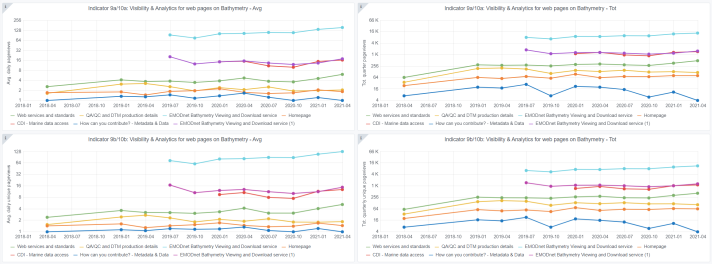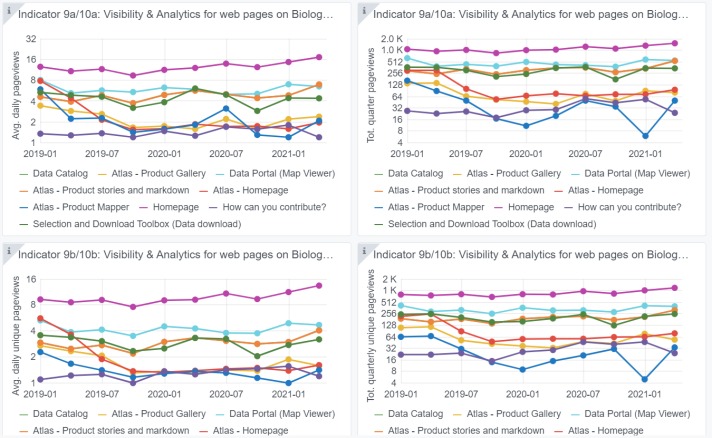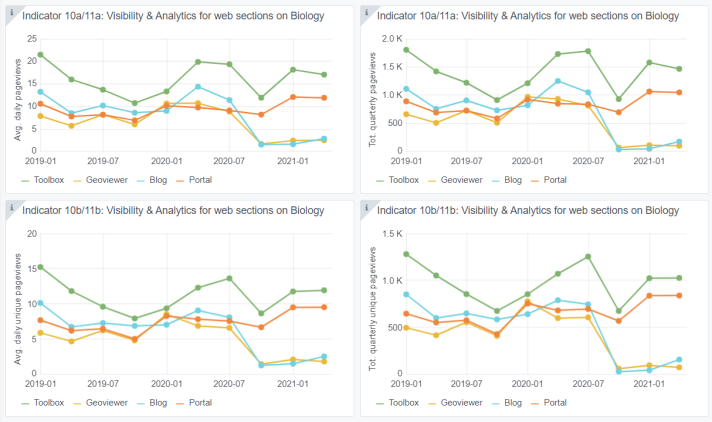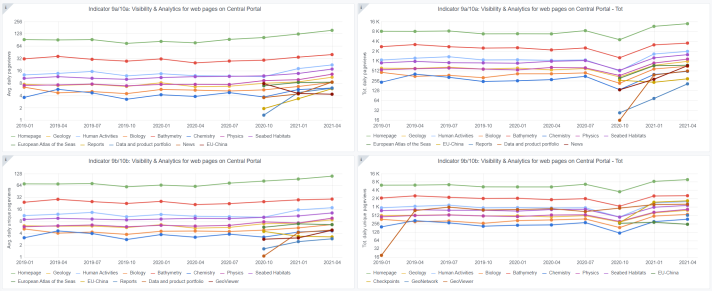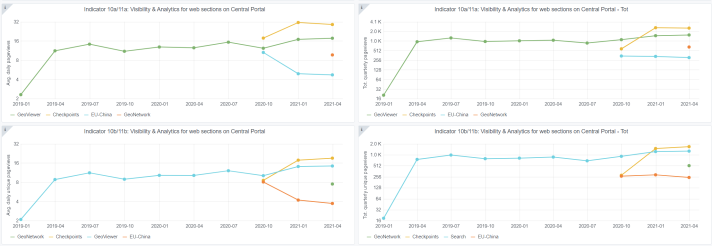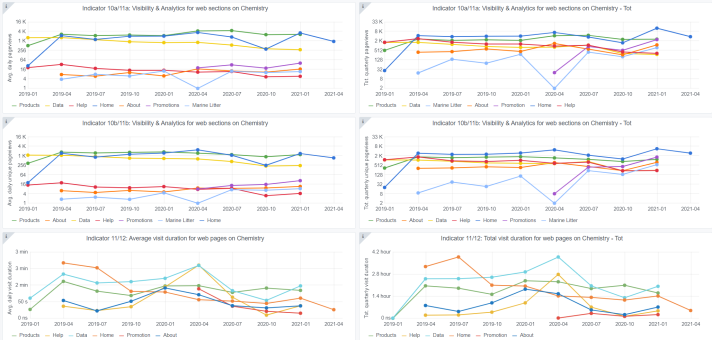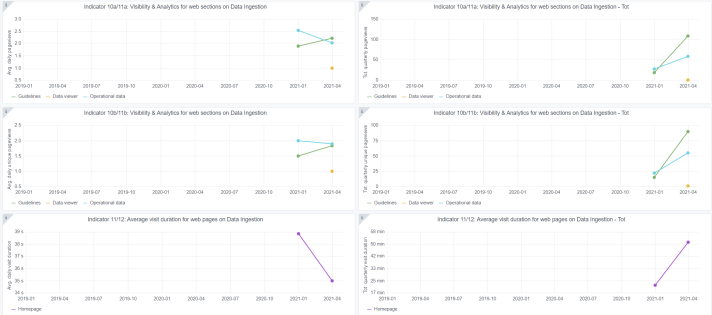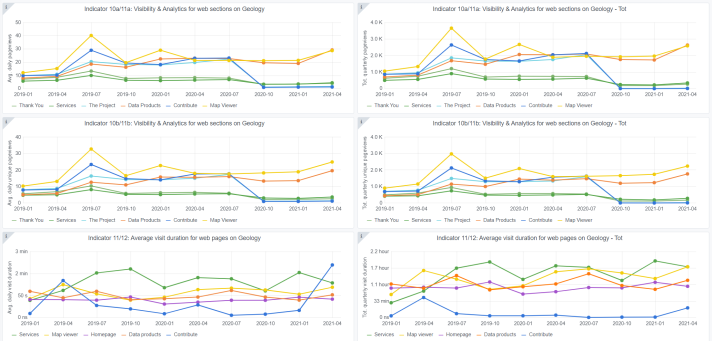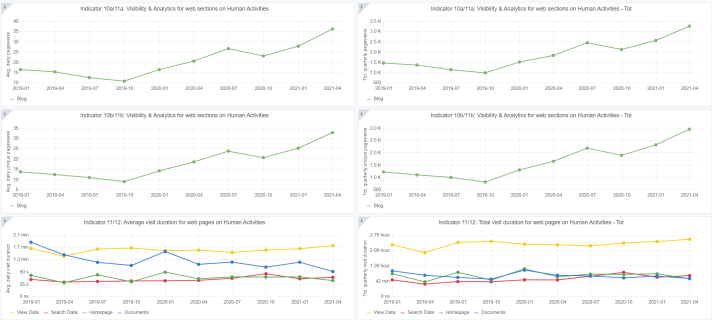EMODnet progress overview
Common progress highlights
On 18 February 2021, the Secretariat released the third video of a series of eight illustrating the fundamental role of EMODnet in society. The third video is about Providing Open Data, supporting Marine Spatial Planning.
From October 2020 to February 2021, the European Commission (DG MARE) ran a public consultation towards a common EU approach to ocean observation. The consultation took part in two phases and aimed to gather opinions on the effectiveness, efficiency and fitness-for-purpose of ocean observation activities by the EU and its member states. The EMODnet Secretariat submitted responses to both the initial consultation on the impact assessment and the wider consultation in February 2021 (download the open document here).
The Secretariat prepared and organized the 14th EMODnet Steering Committee and 9th Technical Working Group meetings (19-21 April), which were attended by all EMODnet thematic coordinators. The 5th Marine Knowledge Expert Group was organized back-to-back. Increasing time and effort is being allocated to the organization of the fully virtual EMODnet Open Conference and Jamboree, taking place on 14-18 June.
The EMODnet Central Portal will soon move under the europa.eu domain; weekly meetings take place between the EMODnet Central Portal Technical Team and the European Commission to guide the process. In the first quarter of 2021, the migration of the individual thematic portals to the Central Portal was kicked-off. EMODnet Bathymetry is the first portal to migrate, followed by EMODnet Human Activities and EMODnet Biology. Regular dedicated meetings between the individual EMODnet thematic lot Coordinators and the EMODnet Central Portal Technical Team are being held to drive this intensive development process and progress.
Specific progress and achievements of the thematic data assembly groups
- EMODnet Bathymetry entered the first quarter of their new Phase IV contract (start date 20 December 2020). The thematic lot’s data set gathering activities will soon start again – gathering new data sets is planned until September 2021, and processing and pre-gridding those datasets by data providers will start in September 2021 with a training workshop to refresh the use of the GLOBE software. In the meantime, the migration of the EMODnet Bathymetry portal was initiated; regular meetings are being held with the EMODnet Central Portal Technical Team. Solution are being searched to also migrate a number of functionalities of the EMODnet Bathymetry Viewing and Download service.
- The harvest cycle of the first quarter of 2021 accounted for 23 new datasets being added to the EurOBIS database and EMODnet Biology portal, bringing the total number of occurrence records to 26.1 million. Fourteen previously available datasets were updated. In the final sprint towards the end of Phase III of Biology, a number of data products were published and promoted by the thematic lot; the Secretariat helped in the promotion of the products. A final end-user workshop was organised by the thematic lot, to demonstrate Phase III achievements and set the agenda for future development; the report will be publicly available.
- EMODnet Chemistry finalised and published a proposal for expanding the Marine Litter data management portfolio with Floating Marine Macro Litter (FMML), underpinning the increasing role of EMODnet Chemistry as European data management hub for many kinds of Marine Litter data. The webODV is operational for eutrophication data collections; very good progress is being made with expanding the interfaces for handling the contaminants data collections. The release of the updated data collections for all groups of parameters is expected in April 2021.
- In the reporting period, EMODnet Geology partner countries contributed new data, which have been integrated into the data products. These updated data products will be released by the end of the project phase in September 2021. In the meantime, a new map was published on coastline migration based on field data and aerial photography. This product should be seen as a companion product to the EMODnet shoreline-migration map based on satellite data, published in 2019. Map products from the Caspian Sea are now available on the Geology portal for coastal behaviour and marine minerals.
- New datasets on Marine Spatial Planning and Power Cables were made available on the EMODnet Human Activities portal. The Government of the Åland Islands submitted their Marine Spatial Plan via EMODnet Data Ingestion; this action illustrates that the thematic lot could become a platform for Member States to transmit their plans. Furthermore, the thematic lot has been working on the design of an INSPIRE-compliant data model for EMODnet Human Activities data, taking as much as possible from the existing INSPIRE land use model.
- EMODnet Physics made available four new products on the portal, related to Underwater noise and Temperature in the water column. In parallel, the EMODnet Physics ERDDAP catalogue was updated with 82 new products consisting of multi value time series with monthly granularity. New datasets (related to Rivers and Sea level, and a new dataset from the Swiss Polar Institute) were added/linked and are available under both the EMODnet Physics and EMODnet Physics ERDDAP catalogues. Interactions are currently ongoing to ingest Arctic data from the ARICE project. EMODnet Physics is now powering the Arctic Data Portal, intended to serve the Arctic community.
- In the quarter covered, 25 new datasets and 3 composite habitat data products were processed and uploaded to the EMODnet Seabed Habitats portal. The next iteration of the EUSeaMap will be delivered in September 2021; it will be the result of the combination of the biological zone layers developed for the version 2019 with the new version of the EMODnet Geology seabed substrate product. The EUSeaMap will be provided in the new version of EUNIS 2019; report on how this translation will be carried out was published. The European Environmental Agency (EEA) updated its datasets from Article 17 from the Habitats Directive (related to the progress made with the implementation of the Directive); in the coming quarter the EMODnet Seabed Habitats lot will publish the most recent dataset using WFS related to the conservation status of habitat types, besides the already available previous version of this dataset.
- In this quarterly period, a total of 49 submissions were recorded by EMODnet Data Ingestion, bringing the total to 903 submissions since the inception of the Ingestion service. In parallel, a number of data centres processed and published 23 submissions ‘as is’, and 26 submissions were elaborated to Phase II implying uptake in European marine data infrastructures feeding into EMODnet, bringing the total to 429 Phase I and 341 Phase II publications respectively. Almost half (43%) of these publications concern datasets related to Physics, followed by Chemistry (26%); there are very few published submissions for Seabed Habitats. EMODnet Data Ingestion and EMODnet Physics successfully identified additional operational oceanography sources to get connected to the European ocean data exchange which is organised together with CMEMS-INSTAC for NRT data and SeaDataNet for archived data. These datasets were made available under the EMODnet Physics and EMODnet Physics ERDDAP catalogue (see EMODnet Physics).
EMODnet data portals usage
User visit statistics
The collection of user statistics (i.e. number of ‘unique’ page views and average visit duration) is done by Matomo and is automated for the following progress/monitoring indicators: Visibility & Analytics for web pages; Visibility & Analytics for web sections; and Average visit duration for web pages. The resulting graphs for each EMODnet thematic lot as well as the Central portal can be viewed in the gallery at the end of this report. Statistics for the Data Ingestion portal are now also available. Unless stated otherwise, pageviews are per day and trends are compared to the previous quarter.
- An average of 12 daily pageviews can be observed for the Homepage on EMODnet Data Ingestion, compared to 10 in the previous quarter. Users spent on average 35 seconds on the Homepage.
- The daily average pageviews increased for the service related webpages (Viewing and Download service, CDI service and Web services and standards) of EMODnet Bathymetry. The first abovementioned page remains the most viewed: a daily average of 156 views was recorded. The average time spent on the Viewing and Download service page remained stable (1.5 minutes). The least amount of time was spent on the CDI service page, with on average 12 seconds.
- Overall, the daily average pageviews remained stable compared to the previous quarter, with the EMODnet Biology Homepage being the most viewed page (daily average of 17 views). The other pages received on average between 1 and 7 pageviews. Similar stable trends were observed for the average visit duration for the different webpages (between 1.8 minutes and 27 seconds), apart from a notable increase in the time spent on the Atlas Product Mapper webpage (from 6.4 seconds to almost 1 minute).).
- Stable to slightly increasing average daily pageviews were observed for the EMODnet Central Portal. The Homepage received 156 average daily pageviews; the other pages (Reports, Portfolio, News, etc.) between 4 and 8 pageviews. Regarding the thematic entry pages, Bathymetry is the most viewed (40 pageviews); least pageviews (6) were recorded for Chemistry. Increasing as well as decreasing visit durations were recorded for the Central Portal pages; on average, users spent between 40 seconds (News) and 1.7 minutes on the pages (Geology).
- Slightly increasing average pageviews were recorded for the various EMODnet Geology webpages. Following the Homepage (23), Data products and Map viewer are the most viewed pages (average of 9 and 8 respectively). On average, users spent between 42 seconds to 1.2 minutes on aforementioned pages. Most time was spent on the Contribute page (2 minutes).
- Increasing trends in average daily pageviews were observed for all webpages of EMODnet Human Activities. View Data remained the most viewed webpage (average of 100 pageviews) and the page on which users spent most of their time (1.7 minutes). This is followed by the Homepage (30) and Search Data page (15); on which users spent 33 to 40 seconds respectively.
- Overall, slight decreases were recorded in the average daily pageviews for the different web pages of EMODnet Physics (e.g. Physics Map from 25 to 19); the other pages received between 1 and 2 daily pageviews. Likewise, decreases in the average daily visit durations were noted, ranging between 10 seconds (Catalogue) and 2.3 minutes (Videos); 1.3 minutes for the Physics Map.
- Slight increases in the average daily pageviews were seen for EMODnet Seabed Habitats. The data-related pages remained the most popular ones in terms of page views: Launch Map Viewer (25.7), Download Data (11.25) and Web Services (3.85). Users spent between 1.6 and 1.9 minutes on aforementioned pages. More time was spent on the page related to the Data Submission Process (2.4 minutes).
Statistics on usage of EMODnet portals[1]
- Number of data downloads[2]:
- An increase of 242% was observed in the number of CDI downloads for EMODnet Bathymetry (from 1358 to 4640). The downloads were performed by 52 users.
- EMODnet Biology reported a 28.5% decrease in the number of data download requests (from 288 to 206).
- A small decrease was reported in the number of CDI downloads for EMODnet Chemistry (-8%, from 46.644 to 43.001 downloads performed by 25 users).
- The total number of datasets downloads on EMODnet Data Ingestion, decreased from 376 to 119 transactions.
- Except very few instances, number of downloads increased for all data sets on the EMODnet Human Activities portal. The most downloaded dataset was the Wind Farms Areas dataset (397 downloads, 99% increase compared to Q4 2020), followed by Schematic Cables (170 downloads, 70%) and Main Ports Goods, Passengers, Vessels (146 downloads, 90% increase).
- Overall, increases were noted in the number of manual data requests for all EMODnet Physics sub-themes (except Winds, River and Underwater Noise), ranging between 25 and 5.403 download requests. There are slight decreases in the number of API requests; nevertheless numbers range between 8.651 and 177.743. Temperature remains the most popular data sub-theme.
- The number of records downloaded on the EMODnet Seabed Habitats portal is comparable to the number downloaded in the previous quarter (30.727.087).
- Number of data product downloads[3]:
- An increase was reported in the number of data files downloads for both the DTM and HR-DTMs products of EMODnet Bathymetry: this quarter, 14.364 DTM tiles were downloaded and 853 HT-DRM files, representing a 91% and 32.5% increase respectively.
- A stable trend was observed in the number of data product downloads for EMODnet Biology (6 downloads).
- A decrease was observed in the number of data products downloads for all EMODnet Chemistry sub-themes. The decreases ranged from -14% to -52%; manual file downloads for this quarter ranged from 43 (Contaminants) to 112 (Chlorophyll).
- Increases in number of dataset downloads were noted for all data products of EMODnet Geology, except for three products: stable trend for Seabed Substrate 250K and Coastal Migration, and slightly decreasing trend for Events & Probabilities (5%). Downloads ranged from 10 to 61 dataset downloads, with the most downloaded data product being Seabed substrate accumulation rates. Likewise, overall increases were noted in the number of WMS and WFS requests. Most requests were done for the Events & Probabilities product (158.389 WMS requests).
- Both the Vessel Density maps and Route Density maps from EMODnet Human Activities were downloaded more frequently compared to the previous quarter. In total 1369 downloads (+4%) were recorded for the Vessel density maps, and 555 downloads (+27%) for the Route density maps.
- EMODnet Physics reported on the usage of data according to the interface the user is using to access data products. The figures indicate that the Wind page is, like previous quarter, the most visited and used page (8.222 map visualisations), followed by the page Sea Level (305 map visualisations).
- A steady increase was recorded in the number datasets downloaded, though there’s a reduction in the number of individual download sessions, suggesting users are downloading a wider variety of datasets in one session on EMODnet Seabed Habitats. The most downloaded dataset/product is Individual Habitats Maps from Surveys (93.383 dataset downloads, representing a 31% increase since Q4 2020), followed by the EUSeaMap (946 downloads, representing a 10% increase).
Recent meetings and events
Due to the CoViD-19 pandemic, all meetings and events in the first quarter of 2021 continued to be organised and/or attended virtually. A number of key meetings:
- EMODnet Bathymetry: presenting of EMODnet Bathymetry and the new DTM at the ‘Mapping the Gaps’ conference with IHO, GEBCO and Seabed 2030.
- EMODnet Biology: attended a workshop on integrating an ecosystem-based approach into maritime spatial planning. A presentation during the Data Solutions for a Chancing Ocean workshop on EMODnet Biology data flow and data products, and a discussion with the participants on how Biology can best support their activities in terms of developing new products and/or new services.
- EMODnet Chemistry: many meetings with CMEMS to discuss progress of the joint portfolio of data products fir for the MSFD purposes. Synergy between Plastic busters interreg MED project and EMODnet Chemistry.
- EMODnet Data Ingestion: meeting with NAUTILOS project who considers to share/link its products with EMODnet. Lecture by INGV on Marine Open Data – a way forward to increase multi-disciplinary ocean knowledge and support the Blue Growth.
- EMODnet Geology: discussion at EuroGeoSurveys Marine Geology Expert Group Annual Meeting about future collaborations. Presentation of EMODnet at Aquatic Sedimentary Environments lectures at Helsinki University.
- EMODnet Human Activities: attendance of a workshop on Marine Data for Aquaculture and a workshop on the Geolittoral Website.
- EMODnet Physics: planning of joint Arctic ROOS activities at the Arctic ROOS General Assembly meeting. Participation in OceanMET workshop to see how marine data communities are using data and which services are under development. Aquaculture in Mediterranean Sea Workshop to discuss and link new marine data in support of aquaculture activities.
- EMODnet Seabed Habitats: meeting with EEA to see how reporting under Nature Directive could be brought together with data processed and disseminated through EMODnet. Workshop on Use of Predictive Habitat Models in ICES Advice, to produce an ICES advice to model deep sea habitats by predictive modelling techniques.
Upcoming EMODnet meetings and events
The main EMODnet meetings planned for the coming period:
- Pre-registration for the EMODnet Open Conference is now open. The second EMODnet Open Conference and Jamboree will be held virtually, from 14 to 16 June 2021. If you are interested in this event and would like to follow the updates, please keep an eye on the updated dedicated page on the EMODnet Central Portal.
More information
More information about EMODnet’s resources available consult:
- EMODnet Data and Data product portfolio: http://www.emodnet.eu/data-portfolio
- EMODnet for Business brochure: http://www.emodnet.eu/emodnet-business-brochure
Thematic portals
- EMODnet Bathymetry - www.emodnet-bathymetry.eu
- EMODnet Geology - www.emodnet-geology.eu
- EMODnet Seabed habitats - www.emodnet-seabedhabitats.eu
- EMODnet Physics - www.emodnet-physics.eu
- EMODnet Chemistry - www.emodnet-chemistry.eu
- EMODnet Biology - www.emodnet-biology.eu
- EMODnet Human Activities - www.emodnet-humanactivities.eu
Sea-basin Checkpoint portals
For an overview of and access to each of the Sea-basin Checkpoint portal, visit: https://emodnet.eu/en/checkpoints
- North Sea checkpoint - https://emodnet.eu/en/checkpoint/north-sea
- Mediterranean checkpoint - https://emodnet.eu/en/checkpoint/medsea
- Artic checkpoint - https://emodnet.eu/en/checkpoint/arctic
- Atlantic checkpoint - https://emodnet.eu/en/checkpoint/atlantic
- Baltic checkpoint - https://emodnet.eu/en/checkpoint/baltic
- Black Sea checkpoint - https://emodnet.eu/en/checkpoint/black-sea
Data Ingestion Service
- Ingestion and safe-keeping of marine data - www.emodnet-ingestion.eu
[1] Disclaimer: please note that percentages given can reflect small as well as large changes in the number of data and data product downloads. Note: Most thematic groups assigned reported decreases in the number of downloads to the COVID-19 situation and summer period. In most cases however it is difficult to provide an actual explanation for the downloading behaviour of users.
[2] For portals which provided this information.
[3] For portals which provided this information.

